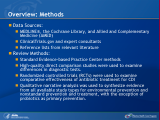- Home
- Slides
- Home
- Tools and Resources
- Research Summaries for Consumers, Clinicians, and Policymakers
- Search for Research Summaries, Reviews, and Reports
- Research Available for Comment
- Submit a Suggestion for Research
- Submit Scientific Information Packets
- Comparative Effectiveness Research Grant and ARRA Awards
- News and Announcements
- What Is Comparative Effectiveness Research
- Who Is Involved in the Effective Health Care Program
- What Is the Effective Health Care Program
Slides
Slides: 1–12 of 132
Clostridium difficile Infections: Diagnosis, Treatment, and Prevention
Outline of this CME Activity
Keywords: antibiotic treatment | diagnostic assays | prevention | recurrence | overview
Overview: Methods
Keywords: analysis | data sources | literature | methods | overview
Adjunctive Devices for Patients With Acute Coronary Syndromes Undergoing Percutaneous Coronary Intervention
Outline of This CME Activity
Rating the Strength of Evidence From the CER
Analgesics for Osteoarthritis—An Update
Presentation: Analgesics for Osteoarthritis—An Update
Keywords: analgesics | comparative effectiveness review | osteoarthritis | systematic review | background
Why Use Analytic Frameworks?
Presentation: Analytic Frameworks
Keywords: systematic review | Evidence-based Practice Center
Depicting Essential Components: An Example
Presentation: Analytic Frameworks
Keywords: analytic framework | components | Evidence-based Practice Center
Key Research Questions
Presentation: Analytic Frameworks
Keywords: key question | analytic framework | components | Evidence-based Practice Center
Angiotensin-Converting Enzyme Inhibitors (ACEIs), Angiotensin II Receptor Antagonists (ARBs), or Direct Renin Inhibitors (DRI) for Adults with Hypertension
Your slide tray is being processed.


 E-mail Updates
E-mail Updates










